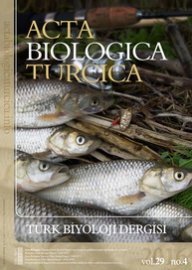Body components indices variations in European sea urchin Paracentrotus lividus (Lamarck, 1871) in Antalya
Abstract
Keywords
Full Text:
PDFReferences
Bannet 1925. Documents paur servir a lotude des voriotions chez les Echinides. Bull ınts Océanogr, 462: 1-28.
Boudoruesgue C.F., Verlague M., Azzolina J.F., Mernesz A., Nédélec H., Rico V. 1989. Evolution des populations de Paracentrotus lividus ef d’Arbacıa lixula (Echinoidea) le long d’un Trnsect permanent o’Goleria (Corse).Trav Sc: Parc Not rég. Res Not Core, 22: 65-82.
Ebert T.A. 1996. Adaptative aspects of phenotypic plasticity in echinoderms. Oceanologica Acta, 19(3-4): 347-355.
Fernandez C., Boudouresque C.F. 1997. Phenotypic plasticity of Paracentrotus lividus (Echinodermata: Echinoidea) in a lagoonal environment. Marine Ecology Progress Series, 152: 145-154.
Köse A. 2005. A study about the gonad productivity and the indices changes of sea urchin (Paracentrotus lividus, Lamarck 1816). Phd in Department of Aquaculture. Bornova-İzmir-Türkiye.
Lawrence J.M., Lawrence A.L., Holland N.D. 1965. Annual cycle in the size of the gut of the purple sea urchin, Strongylocentrotus purpuratus (Stimpson). Nature, 205: 1238-1239.
Lozano J., Galero J., Lopez S., Turon X., Polacin C., Morera G. 1995. Biological cycles and recruitment of Paracentrotus lividus (Echinodermota: Echinoidea) in two contrasting habitats. Marine Ecology Progress Series, 122: 197-191.
Lök A., Köse A. 2006. Urla İskele’den toplanan deniz kestanelerinin (Paracentrotus lividus, Arbacia lixula) gonadosomatik indeks değişimi. Ege Üniversitesi Su Ürünleri Dergisi, 23(1-2): 7-11.
Pizzola P.F. 2002. Paracentrotus lividus. Purple sea urchin. Marine Life information. Network: Biology and Sensitivity Key Information sub-programme.
Murillo-Navarro R., Jimenez-Guirado D. 2012. Relationship between algal food and gut and gonad conditions in the Mediterranean Sea urchin Paracentrotus lividus (Lam.) Mediterranean Marine Science, 13(2): 227-238.
Soualili D., Guillou M. 2009. Variations in the reproductive cycle of the sea urchin Paracentrotus lividus in three differently polluted locations near Algiers (Algeria). Marine Biodiversity Records, 1-6.
Spirlet C., Grasjean P., Jangaux M. 1998. Reproductive cycle of echinoid Paracentrotus lividus: analysis by means of the maturity index. Invertebrate Reproduction and Development, 34(1): 69-81.
Spirlet C., Grosjean P., Jangoux M. 2000. Optimization of gonad growth by manipulation of temperature and photoperiod in cultivated sea urchins, Paracentrotus lividus (Lamarck) (Echinodermata). Aquaculture, 185: 85-99.
Refbacks
- There are currently no refbacks.

